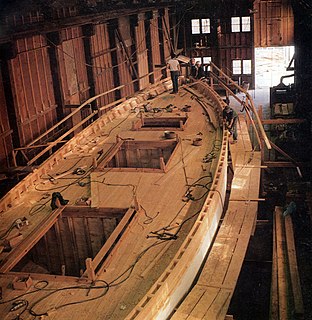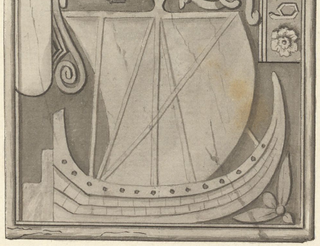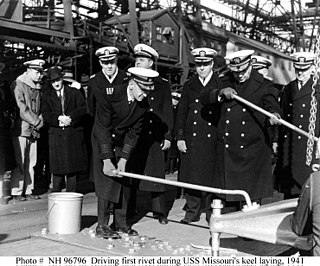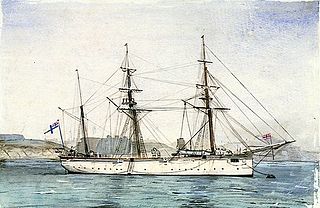
Longships were a type of specialised Scandinavian warships that have a long history in Scandinavia, with their existence being archaeologically proven and documented from at least the fourth century BC. Originally invented and used by the Norsemen for commerce, exploration, and warfare during the Viking Age, many of the longship's characteristics were adopted by other cultures, like Anglo-Saxons, and continued to influence shipbuilding for centuries.

Ceremonial ship launching involves the performance of ceremonies associated with the process of transferring a vessel to the water. It is a nautical tradition in many cultures, dating back thousands of years, to accompany the physical process with ceremonies which have been observed as public celebration and a solemn blessing, usually but not always, in association with the launch itself.

A sailboat or sailing boat is a boat propelled partly or entirely by sails and is smaller than a sailing ship. Distinctions in what constitutes a sailing boat and ship vary by region and maritime culture.

A barque, barc, or bark is a type of sailing vessel with three or more masts having the fore- and mainmasts rigged square and only the mizzen rigged fore and aft. Sometimes, the mizzen is only partly fore-and-aft rigged, bearing a square-rigged sail above.

Shipbuilding is the construction of ships and other floating vessels. It normally takes place in a specialized facility known as a shipyard. Shipbuilders, also called shipwrights, follow a specialized occupation that traces its roots to before recorded history.

The keel is the bottom-most longitudinal structural element on a vessel. On some sailboats, it may have a hydrodynamic and counterbalancing purpose, as well. As the laying down of the keel is the initial step in the construction of a ship, in British and American shipbuilding traditions the construction is dated from this event.

Boat building is the design and construction of boats and their systems. This includes at a minimum a hull, with propulsion, mechanical, navigation, safety and other systems as a craft requires.

A currach is a type of Irish boat with a wooden frame, over which animal skins or hides were once stretched, though now canvas is more usual. It is sometimes anglicised as "curragh".
This is a glossary of nautical terms; some remain current, while many date from the 17th to 19th centuries. See also Wiktionary's nautical terms, Category:Nautical terms, and Nautical metaphors in English. See the Further reading section for additional words and references.

The ancient Egyptians had an elaborate set of funerary practices that they believed were necessary to ensure their immortality after death. These rituals included mummifying the body, casting magic spells, and burials with specific grave goods thought to be needed in the afterlife.

The Kyrenia Ship is the wreck of a 4th-century BC ancient Greek merchant ship. It was discovered by Greek-Cypriot diving instructor Andreas Cariolou in November 1965 during a storm. Having lost the exact position, Cariolou carried out more than 200 dives until he re-discovered the wreck in 1967 close to Kyrenia in Cyprus. Michael Katzev, a graduate student at the University of Pennsylvania Museum of Archaeology and Anthropology, directed a scientific excavation from 1967–69. Preservation of the ship's timbers continued during the winter of 1970. Katzev later was a co-founder of the Institute of Nautical Archaeology. The find was extensively covered in a documentary by the Cyprus Broadcasting Corporation titled "With Captain, Sailors Three: The Ancient Ship of Kyrenia"]. The ship itself was very well preserved with approximately 75% of its hull in good condition. It found a new home at the Ancient Shipwreck Museum in Kyrenia Castle, where it remains on exhibit.

The birlinn was a wooden vessel propelled by sail and oar, used extensively in the Hebrides and West Highlands of Scotland from the Middle Ages on. Variants of the name in English and Lowland Scots include "berlin" and "birling". The Gaelic term may derive from the Norse byrðingr. It has been suggested that a local design lineage might also be traceable to vessels similar to the Broighter-type boat, equipped with oars and a square sail, without the need to assume a specific Viking design influence. It is uncertain, however, whether the Broighter model represents a wooden vessel or a skin-covered boat of the currach type. The majority of scholars emphasise the Viking influence on the birlinn.

The Hjortspring boat is a vessel designed as a large canoe, from the Scandinavian Pre-Roman Iron Age. It was built circa 400–300 BC. The hull and remains were rediscovered and excavated in 1921–1922 from the bog of Hjortspring Mose on the island of Als in Sønderjylland, southern Denmark. The boat is the oldest find of a wooden plank ship in Scandinavia and it closely resembles the thousands of petroglyph images of Nordic Bronze Age ships found throughout Scandinavia. The vessel is a clinker-built wooden boat of more than 19 metres length overall, 13.6 metres long inside, and 2 metres wide. Ten thwarts that could have served as seats, span the boat with room for two persons each; this suggests space for a crew of at least 20 who propelled the boat with paddles. The boat would have weighed an estimated 530 kilograms (1,168 lb), making it easily portable by its crew.
The coin ceremony is an event which takes place at the keel laying, in the early stages of a ship's construction. In it, the shipbuilders place one or two coins under the keelblock of the new ship to bless the ship and as a symbol of good fortune. The coins are not normally fixed in place and are often retrieved when the ship sails out of the dry-dock,.

The log canoe is a type of sailboat developed in the Chesapeake Bay region. Based on the dugout, it was the principal traditional fishing boat of the bay until superseded by the bugeye and the skipjack. However, it is most famous as a racing sailboat, and races continue to be held.

Laying the keel or laying down is the formal recognition of the start of a ship's construction. It is often marked with a ceremony attended by dignitaries from the shipbuilding company and the ultimate owners of the ship.

HMS Mariner was the name-ship of the Royal Navy Mariner-class composite screw gunvessel of 8 guns.
The Blackfriars shipwrecks were a series of wrecks discovered by archaeologist Peter Marsden in the Blackfriars area of the banks of the River Thames in London, England. The wrecks were discovered while building a riverside embankment wall along the River Thames. Marsden discovered the first on 6 September 1962 and the next two were discovered in 1970. A later discovery added to the previous three wrecks, constituting now what is known as the four Blackfriars wrecks.
Sailors' superstitions have been superstitions particular to sailors or mariners, and which traditionally have been common around the world. Some of these beliefs are popular superstitions, while others are actually better described as traditions, stories, folklore, tropes, myths, or legend.















